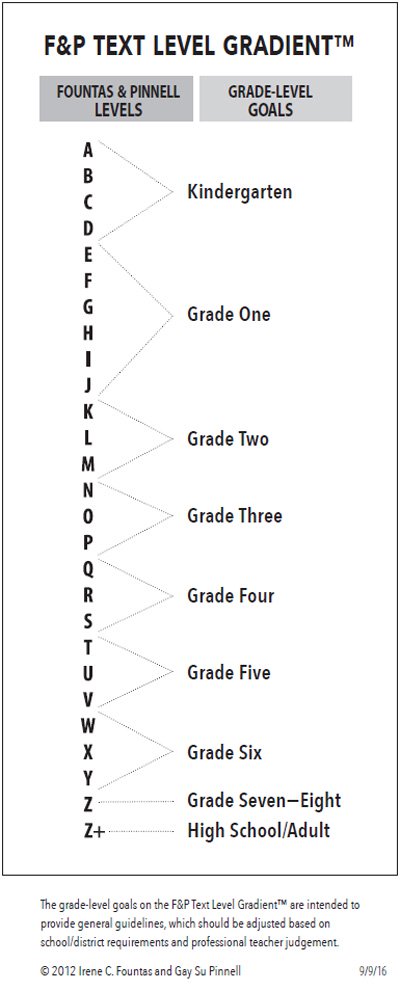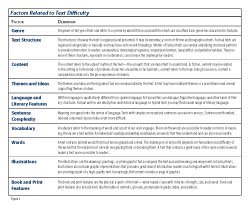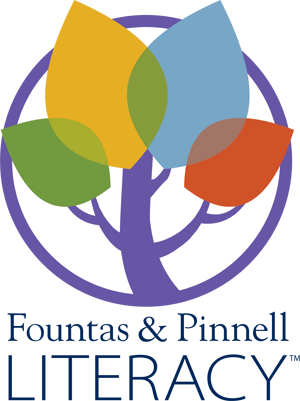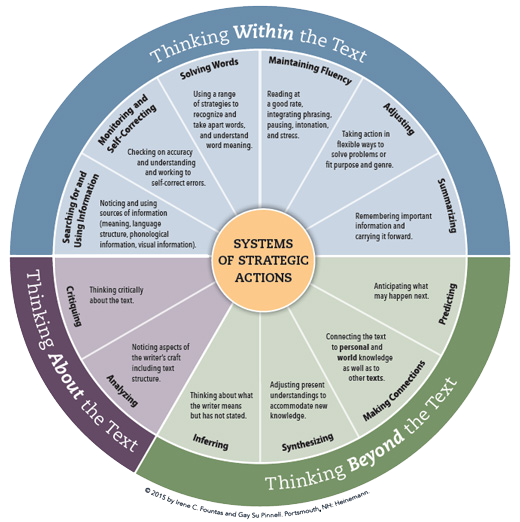Fountas & Pinnell Literacy™
With over 20 years of literacy leadership, the extensive work of Irene Fountas and Gay Su Pinnell has coalesced into Fountas & Pinnell Literacy™: a comprehensive, systematic design for high-impact literacy instruction. Transformative professional development underpins Fountas & Pinnell Literacy™—insightful Assessment, effective Intervention, practical Professional Books, and essential Classroom Resources—to redefine and elevate literacy teaching and learning.
-
Vision and Core Values
Vision
The schools we envision recognize every child’s right to grow up literate as a member of a dynamic learning community that values the richness of linguistic, ethnic, and cultural diversity. Members of the school community are treated and treat others with empathy, kindness, and respect. Students are motivated to investigate new ideas that fuel intellectual curiosity and act as powerful agents in their own learning. Because students are fully engaged and feel a sense of joy in their own learning, they achieve a higher level of literacy. Through dynamic literacy education that exemplifies the beliefs and core values described below, students come to understand their physical, social, and emotional world and their roles as informed global citizens—hallmarks of the literate lives they can lead.
Core Values
Schools are places where students:
- Act as members of a cohesive learning community that sustains their literacy growth and success.
- Engage in authentic inquiry within and beyond the classroom walls to ignite their intellectual curiosity and expand their knowledge of the world and of others.
- Believe in themselves and their own ability to acquire and use language and literacy for learning and enjoyment.
- Read, think about, talk about, and write about relevant content that engages their hearts and minds every day.
- Read, think about, talk about, and write about texts that are culturally sensitive, reflect the diversity in our world, and vary in genre, content, and perspective.
Schools are places where literacy educators:
- Implement a coherent set of evidence-based instructional practices in whole-class, small-group, and individual contexts.
- Make expert instructional decisions based on evidence gained from systematic observation and ongoing assessment data.
- Work as a team to take collective responsibility for the high achievement of each student in a widely diverse population.
- Act as members of a community with a common vision, common goals, common language, and a strong belief that their work can transform children’s lives through literacy.
- Demonstrate an unwavering commitment to their own professional learning and to support the learning of their colleagues and team members.
-
F&P Text Level Gradient™

Reading is a highly complex process. Readers must build a system of strategic actions for processing texts A–Z+ that begins with early reading behaviors and becomes a network of strategic actions for reading increasingly difficult texts. The F&P Text Level Gradient™ should be seen as a continuum of progress for readers.
The F&P Text Level Gradient™ is the most recognized and trusted tool for selecting books for small-group reading instruction. All of Fountas and Pinnell's work references their F&P Text Level Gradient™—often referred to as Guided Reading levels or F&P levels—beginning with the publication of Guided Reading: Good First Teaching for All Children, and extending to the publication of The Continuum of Literacy Learning, the Benchmark Assessment System 1 and 2 and the Leveled Literacy Intervention Systems.
Fountas and Pinnell's goal is to support the child's development of self-initiating actions he will be able to apply to a range of texts of similar difficulty. With daily teaching, the teacher helps the child climb the ladder of text difficulty with success. The goal of guided reading is to bring the child to the level of complex texts appropriate for the grade, in doing so, teaching must begin with where the child is able to engage with some success, so that there is a point of contact, thereby engaging the child's development of a self-extending system for processing texts.
Factors Related to Text Difficulty - Chart
 This document defines the ten text characteristics from The Fountas & Pinnell Literacy Continuum, which are the main factors related to text difficulty. Studying the text characteristics of books at a given level will provide a good inventory of the challenges readers will meet across that level. These ten text factors are important to consider when selecting texts for any kind of reading instruction.
This document defines the ten text characteristics from The Fountas & Pinnell Literacy Continuum, which are the main factors related to text difficulty. Studying the text characteristics of books at a given level will provide a good inventory of the challenges readers will meet across that level. These ten text factors are important to consider when selecting texts for any kind of reading instruction. The full version of this resource requires registration.
The full version of this resource requires registration.
-
Our Brand

 Assessment
AssessmentThe Benchmark Assessment Systems are accurate and reliable tools to identify the instructional and independent reading levels of all students and document student progress through one-on-one formative and summative assessments.
 Classroom Resources
Classroom ResourcesClassroom Resources maximize student learning with systematic lessons, student books and materials, and powerful tools that guide teachers’ language and actions and support them in expert decision making for high-impact literacy instruction.
 Intervention
InterventionLeveled Literacy Intervention is a short-term, supplementary intervention proven to improve literacy achievement of struggling readers with engaging leveled books and fast-paced, systematically designed lessons.
 Professional Books
Professional BooksProfessional Books empower teachers with highly effective instructional procedures and the latest in literacy thinking to elevate their expertise and help build a community of skillful, informed educators.
 Professional Development
Professional DevelopmentProfessional Development offers options and opportunities to further develop the teaching craft and foster a climate of collegiality and community through School-Based Seminars, Multi-Day Institutes, and Live Webinars.
-
Systems of Strategic Actions
 What is the Systems of Strategic Actions? Any one of the many simultaneous, coordinated thinking activities that occur in a reader's head. The diagram represents the three ways of thinking about a text while reading:
What is the Systems of Strategic Actions? Any one of the many simultaneous, coordinated thinking activities that occur in a reader's head. The diagram represents the three ways of thinking about a text while reading:- Thinking Within the Text: Readers efficiently and effectively understand what is on the page—the author's literal message.
- Thinking Beyond the Text: Readers make inferences and put text ideas together in different ways to construct the text's meaning.
- Thinking About the Text: Readers analyze and critique the author's craft.


